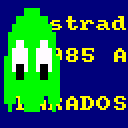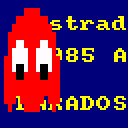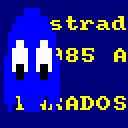A great feature of the Amstrad CPC plus is hardware sprites. Hardware sprites are handled by the ASIC. The ASIC can handle up to 16 sprites per scanline, each hardware sprite is always 16 x 16 pixels of size.
The data
Each sprite can display 15 distinct colours, the pixel colours are indexed #0 - #F.
Index #0 is always transparency, whereas index #1 - #F is the colour index in the sprite palette.
To define a sprite in the ASIC. 16 x 16 (256) bytes must be transferred to the ASIC.
The format of the data is straight forward. The data is organized in a linear manner. Each sprite pixel uses a single byte, the upper nibble is ignored by the ASIC.
The colour palette
The ASIC can handle 4096(16x16x16) colours. Each colour is defined as values of red, green and blue. Each value is handled as 4bit values.
The hardware code send to the ASIC is #0grb.
In the below example changing the palette index colour 1 to value #0F00 gives a green Pac sprite.
changing the palette index colour 1 to value #00F0 gives a red Pac sprite.
and finally changing the palette index colour 1 to value #000F gives a blue Pac sprite.
Example
Below is shown an example of how a sprite is organized into raw data. To transfer the sprite data to the ASIC look here: Transfer to ASIC
<geshi lang=Z80> .pac_sprite
- The raw sprite data - to be transfered to the ASIC
db #00,#00,#00,#00,#00,#00,#00,#00,#00,#00,#00,#00,#00,#00,#00,#00 db #00,#00,#00,#00,#00,#00,#01,#01,#01,#01,#00,#00,#00,#00,#00,#00 db #00,#00,#00,#00,#01,#01,#01,#01,#01,#01,#01,#01,#00,#00,#00,#00 db #00,#00,#00,#01,#01,#01,#01,#01,#01,#01,#01,#01,#01,#00,#00,#00 db #00,#00,#01,#01,#01,#01,#01,#01,#01,#01,#01,#01,#01,#01,#00,#00 db #00,#00,#01,#01,#03,#03,#01,#01,#01,#01,#03,#03,#01,#01,#00,#00 db #00,#00,#01,#03,#03,#03,#03,#01,#01,#03,#03,#03,#03,#01,#00,#00 db #00,#01,#01,#03,#03,#03,#03,#01,#01,#03,#03,#03,#03,#01,#01,#00 db #00,#01,#01,#03,#02,#02,#03,#01,#01,#03,#02,#02,#03,#01,#01,#00 db #00,#01,#01,#01,#02,#02,#01,#01,#01,#01,#02,#02,#01,#01,#01,#00 db #00,#01,#01,#01,#01,#01,#01,#01,#01,#01,#01,#01,#01,#01,#01,#00 db #00,#01,#01,#01,#01,#01,#01,#01,#01,#01,#01,#01,#01,#01,#01,#00 db #00,#01,#01,#01,#00,#01,#01,#01,#01,#01,#01,#00,#01,#01,#01,#00 db #00,#00,#01,#00,#00,#00,#01,#01,#01,#01,#00,#00,#00,#01,#00,#00 db #00,#00,#00,#00,#00,#00,#00,#00,#00,#00,#00,#00,#00,#00,#00,#00 db #00,#00,#00,#00,#00,#00,#00,#00,#00,#00,#00,#00,#00,#00,#00,#00
- Compressed data
db #00,#00,#00,#00,#00,#00,#00,#00 db #00,#00,#00,#11,#11,#00,#00,#00 db #00,#00,#11,#11,#11,#11,#00,#00 db #00,#01,#11,#11,#11,#11,#10,#00 db #00,#11,#11,#11,#11,#11,#11,#00 db #00,#11,#33,#11,#11,#33,#11,#00 db #00,#13,#33,#31,#13,#33,#31,#00 db #01,#13,#33,#31,#13,#33,#31,#10 db #01,#13,#22,#31,#13,#22,#31,#10 db #01,#11,#22,#11,#11,#22,#11,#10 db #01,#11,#11,#11,#11,#11,#11,#10 db #01,#11,#11,#11,#11,#11,#11,#10 db #01,#11,#01,#11,#11,#10,#11,#10 db #00,#10,#00,#11,#11,#00,#01,#00 db #00,#00,#00,#00,#00,#00,#00,#00 db #00,#00,#00,#00,#00,#00,#00,#00
.pac_sprite_palette
- Sprite ink 1
dw #0CDF ; Red = #D Green = #C Blue = #F ; The gray body
- Sprite ink 2
dw #0000 ; Red = #0 Green = #0 Blue = #0 ; The black in the PAC's eyes
- Sprite ink 3
dw #0FFF ; Red = #F Green = #F Blue = #F ; The white in the PAC's eyes </geshi>


